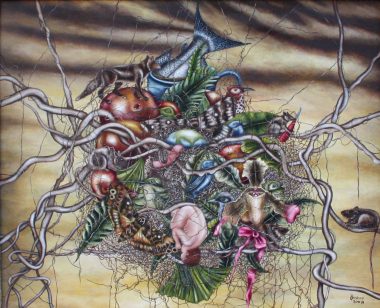by John Clark, via brooklynrail.org

Jacqueline Bishop, “Edge”, 2008. Oil on Belgian linen. 13.5 × 16.5″.
Thoreau famously proclaimed that, “in wildness is the preservation of the world.” And, as Gary Snyder explains, the poetic mind, the mind of the creative artist, is a realm of wildness. Thus, the eco-syllogism: preservation of the world depends on the wild. The poetic mind is wild. Therefore, the preservation of the world depends on the poetic mind.
What we call “art” is, in reality, technopoesis—the convergence of skillful technique and the creative act. The techne may be the use (or creative non-use) of words, paint, pen and ink, stone or marble, clay, film, the human body and voice, musical notes, or building materials. However, the crucial factor is always that the techne is an expression of poesis.
The problem of our age is that techne and poesis have split. Techne, under the control of capital, has become the great destructive force, devastating mind, spirit, and nature. We have been under the sway of the global death drive, as expressed in the classic formula “money-capital-money.” It has been rightly said that our hope lies in l’imagination au pouvoir (power to the imagination). This really means power to poesis, to life and creativity.
Both nature and artistic creativity act through what Daoist thought calls wuwei, doing without “doing” in the sense of manipulating or dominating. This is what the creative artist does through negative capability and what creative nature has been doing throughout the history of life on earth. “Sitting quietly, doing nothing, Spring comes, and the grass grows, by itself.” The system of domination annihilates this greening of the Earth, this greening of the mind.
The combat for the soul of art is thus one with the combat for the soul of nature. It is about arché versus anarché. It is about the defense of vitality, creative growth, and emergence against the forces of power and profit. Artistic and ecological struggles are one in defending the wild against their common enemy, the ethos and psychology of domination that has been shaped by the megamachine, capital, the state, and patriarchy.
One of the burning questions recently has been what we should call our current geological epoch. “Anthropocene” has been winning. To be a little less self-centered and much more realistic, we might call it the “Thanatocene,” the age of reversal of the creative activity, the poesis, of the Earth.
But what should we call the next epoch, if there is one, in which we put an end to this era of Death on Earth? We should perhaps call it the Poeticene, since it would be the epoch in which the creative powers of both the Earth and the creatures of the Earth would be allowed to reassert themselves.
It would be an epoch in which all would be allowed to be artists, or poets, in the sense of radically creative beings. In such a poetic democracy, poets would become the acknowledged legislators of the world. And the Earth would be acknowledged again as the Great Poet, the Artist of all artists.
